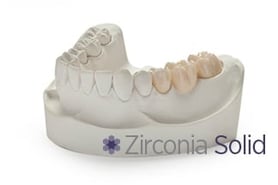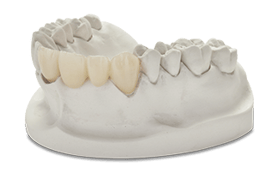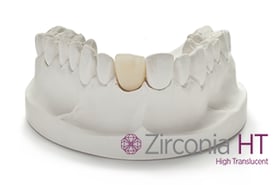Clinicians who wish to provide patients with aesthetic dental restorations often choose zirconia crowns. These crowns are selected over conventional PFMs (Porcelain Fused-to-Metal) or full gold crowns due to their superior strength, durability, and excellent aesthetics.
Some dentists exclusively use zirconia over all-ceramic restorations, mainly when restoring a single tooth. Zirconia crowns require shoulder or chamfer margins for best results. They may be fabricated from solid full-contour zirconia, high translucent zirconia, or layered zirconia. High translucent zirconia and layered zirconia can be either screw-retained or cemented.
Most dental practices are switching from conventional PFM crowns and moving towards the use of zirconia for creating fixed dental restorations. Because zirconia restorations possess excellent aesthetics and are virtually indestructible, zirconia is becoming the most popular material for fabricating dental restorations.
Solid or Layered Zirconia?
 Solid zirconia, or “monolithic zirconia,” is opaque, so it’s generally recommended for posterior crowns. Solid zirconia contains more stabilizers than high translucent zirconia, making it more durable to withstand the forces of mastication. This material is particularly suitable for patients who may grind their teeth. Only minimal clearance is required for this type of restoration, and there is low wear on the opposing teeth. Solid zirconia is also very effective for masking highly discolored dental preps, specifically those that have darkened due to previous dental treatments, such as a post and core or an implant-supported restoration.
Solid zirconia, or “monolithic zirconia,” is opaque, so it’s generally recommended for posterior crowns. Solid zirconia contains more stabilizers than high translucent zirconia, making it more durable to withstand the forces of mastication. This material is particularly suitable for patients who may grind their teeth. Only minimal clearance is required for this type of restoration, and there is low wear on the opposing teeth. Solid zirconia is also very effective for masking highly discolored dental preps, specifically those that have darkened due to previous dental treatments, such as a post and core or an implant-supported restoration.
 Layered zirconia is more translucent and opalescent, but it is especially suitable for anterior crowns, unlike solid zirconia. Although generally used for anterior crowns, layered zirconia may also be used for posterior crowns if there is sufficient clearance. When done skillfully, the very best aesthetic results can be achieved. Both solid and layered zirconia crowns have strength and consistency comparable with traditional PFM restorations, yet they provide far superior aesthetics.
Layered zirconia is more translucent and opalescent, but it is especially suitable for anterior crowns, unlike solid zirconia. Although generally used for anterior crowns, layered zirconia may also be used for posterior crowns if there is sufficient clearance. When done skillfully, the very best aesthetic results can be achieved. Both solid and layered zirconia crowns have strength and consistency comparable with traditional PFM restorations, yet they provide far superior aesthetics.
Zirconia HT

Zirconia HT (High Translucent), at 590-720 MPa, is much stronger than porcelain-fused-to-metal (PFM) restorations and maintains a natural and vibrant translucency.
The product is 100% metal-free, which prevents gingival darkening and removes the possibility of exposing metallic margins if gingival recession begins. They are naturally aesthetic, transmit the color of adjacent teeth, and can be matched to any shade, making high-translucent zirconia suitable for bridges up to 3 units in length.
Using Zirconia HT can save your patients more than three hours since there is no need for shading liquids or drying time. Due to its inherent natural fluorescence in any lighting condition—whether daylight, sunshine, or black light—restorations will always look natural. No unique fluorescent glaze is required.
View Zirconia HT product details ›
Safer for your patients
The high biocompatibility of zirconia will not cause an allergic reaction in patients who have sensitivities to PFM restorations. Quite a few dental patients are allergic to the alloys used to fabric PFM crowns. If you have a patient who faces these allergies, this is an indication that zirconia should be used when making restorations. Zirconia possesses excellent biocompatibility, making the crowns and bridges prepared from zirconia highly safe for clinical use.
Advantages of choosing Zirconia Crowns
- Zirconia crowns are highly biocompatible, as the smooth surface helps to reduce plaque accumulation. Layered zirconia crowns are highly durable. Even though the porcelain used for layering does not have the strength of solid zirconia, they are designed to bond with the zirconium substructure, making chipping or fracturing extremely rare. The material also promotes a healthy tissue response.
- Due to a wide variety of factors, including chemical composition and processing requirements, there are many ways zirconia can be manufactured to suit the needs of the patient. This customization minimizes the margin for error and ensures an excellent fit for each individual.
- Zirconia is suitable for patients with metal allergies or who would prefer to have metal-free restorations.
- Zirconia is metal-free, preventing darkening around the gingival margin in patients with thin biotypes. This eliminates the possibility of metal margins becoming exposed due to gingival recession.
- The translucent nature of this material can transmit the color of adjacent teeth, and it is manufactured in a wide variety of shades, making it easy to match the color of the patient’s natural teeth accurately.
- Computer-aided design and manufacturing processes provide patients with a precise fit, thus reducing the chairtime required to adjust and cement these restorations.
 Zirconia crowns can be conventionally cemented in place by using Bisco’s Z-Prime™ Plus, then applying the bonding agent of choice to prep, followed by dual-cure resin cement.
Zirconia crowns can be conventionally cemented in place by using Bisco’s Z-Prime™ Plus, then applying the bonding agent of choice to prep, followed by dual-cure resin cement.- Zirconia crowns are comfortable for patients as they do not transmit hot and cold like conventional PFMs.
Are there any disadvantages of having a Zirconia Crown?
The disadvantages of zirconia crowns are minimal. The material's toughness has raised some concerns about friction against the tooth root and wearing down opposing teeth. However, frequent check-ups help reduce the possibility of damaging opposing teeth. Initially, only bone-white substructures could be produced for zirconia crowns, sometimes creating problems in achieving an aesthetically-perfect appearance.
However, the newer materials are pre-shaded and can be fabricated to provide highly aesthetic and natural-looking restorations with minimal tooth reduction, thus meeting or even exceeding patient demands for high-quality work! The need for zirconia far exceeds the demand for PFMs, and these older-style restorations are becoming a thing of the past.
Please be reminded that our experienced technical team is here to assist you should you wish to discuss a case in more detail.
Click here to schedule a consultation with our technical team ›
 Resources:
Resources:
Z-Prime™ Plus is a trademark of Bisco, Inc.